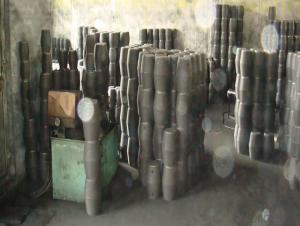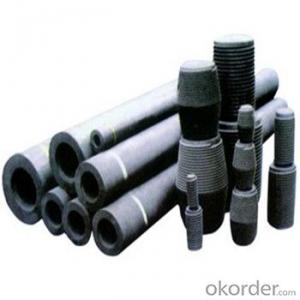Graphite Electrode with Technical Properties from CNBM
- Loading Port:
- Shanghai
- Payment Terms:
- TT or LC
- Min Order Qty:
- 10 m.t.
- Supply Capability:
- 100000 m.t./month
OKorder Service Pledge
OKorder Financial Service
You Might Also Like
TECHNICAL PROPERTIES OF GRAPHITE ELECTRODE
1.Physical and chemical index
Item | Unit | RP | HP | UHP | ||||
250-400 | 450-800 | 300-400 | 450-700 | 300-400 | 450-700 | |||
Electric Resistivity | Electrode | μΩ.m | 7.5-8.6 | 7.5-8.8 | 5.5-6.8 | 5.5-7.0 | 4.6-6.0 | 4.8-6.2 |
Nipple | 4.5-5.5 | 4.0-5.0 | 3.5-4.5 | |||||
Bending Strength | Electrode | MPa | ≥8.0 | ≥11.0 | ≥11.0 | |||
Nipple | ≥15.0 | ≥16.0 | ≥18.0 | |||||
Elastic Modulus | Electrode | GPa | ≤9.0 | ≤11.0 | ≤13.0 | |||
Nipple | ≤13.0 | ≤14.0 | ≤15.0 | |||||
Bulk Density | Electrode | g/cm3 | 1.55-1.65 | 1.63-1.73 | 1.65-1.75 | |||
Nipple | 1.70-1.75 | 1.73-1.80 | 1.75-1.82 | |||||
Ash | Electrode | % | ≤0.3 | |||||
Nipple | ||||||||
CTE (100-600)℃ | Electrode | 10-6/℃ | 2.00-2.50 | 1.80-2.00 | 1.30-1.50 | |||
Nipple | 1.50-1.80 | 1.50-1.80 | 1.20-1.40 | |||||
2.Recommended current carrying capacity
Nominal Diameter (mm) | RP | HP | UHP | ||||
Current Carrying Capacity | Current Density | Current Carrying Capacity | Current Density | Current Carrying Capacity | Current Density | ||
in | mm | A | A/cm2 | A | A/cm2 | A | A/cm2 |
12 | 300 | 1000-13000 | 14-18 | 13000-174000 | 17-24 | 15000-22000 | 20-30 |
14 | 350 | 13500-18000 | 14-18 | 17400-24000 | 17-24 | 20000-30000 | 20-30 |
16 | 400 | 18000-23500 | 14-18 | 21000-31000 | 16-24 | 25000-40000 | 19-30 |
18 | 450 | 22000-27000 | 13-17 | 25000-40000 | 15-24 | 32000-45000 | 19-27 |
20 | 500 | 25000-32000 | 13-16 | 30000-48000 | 15-24 | 38000-55000 | 18-27 |
22 | 550 | 32000-40000 | 13-16 | 35000-55000 | 14-22 | 42000-64000 | 17-26 |
24 | 600 | 35000-41000 | 13-15 | 41000-61000 | 14-21 | 50000-73000 | 17-25 |
28 | 700 | 39000-48000 | 10-12 | 55000-82000 | 14-21 | 67000-99000 | 17-25 |
32 | 800 | 43000-54000 | 8-10 | / | / | / | / |
TOLERANCCES OF ELECTRODE DIAMETERS AND LENG THES (MM)
Nominal Diameter | Actual Diameter | Length | |||
in | mm | max | min | Black surface min | |
12 | 300 | 307 | 302 | 299 | 1800/2000 |
14 | 350 | 357 | 352 | 349 | 1800/2000/2200 |
16 | 400 | 409 | 403 | 400 | 1800/2000/2200 |
18 | 450 | 460 | 454 | 451 | 1800/2000/2200 |
20 | 500 | 511 | 505 | 502 | 2000/2200/2400 |
22 | 550 | 562 | 556 | 553 | 2000/2200/2400 |
24 | 600 | 613 | 607 | 604 | 2200/2400/2700 |
28 | 700 | 714 | 708 | 705 | 2400/2700 |
29 | 800 | 815 | 809 | 806 | 2700/3000 |
SIZE OF TAPER-THREAD NIPPLES AND SOCKETS(MM)
Nominal Length | Standard Deviation | Deviation of the short scale length | ||
1800 | +100 | -100 | -100 | -275 |
2000 | +100 | -100 | -100 | -275 |
2200 | +100 | -100 | -100 | -275 |
2400 | +100 | -100 | -100 | -275 |
2700 | +150 | -150 | -150 | -300 |
3000 | +150 | -150 | -150 | -300 |
FINE-GRAIN SPECIALTY GRAPHITE FXG-1
Physical and chemical index
Item | Unit | Guarantee Value | Typical Value |
Max Grante Size | mm | 0.8 | 0.8 |
Bulk Density | g/cm3 | ≥1.70 | 1.73 |
Specific Resistance | μΩ.m | ≤8.5 | 7.5 |
Bending Strength | MPa | ≥10.0 | 11.0 |
Compressive Strength | MPa | ≥24.0 | 27.0 |
Thermal Conductivity | W/(m.k) | ≥120 | 150 |
CTE (100-600)℃ | 10-6/℃ | ≤2.5 | 2.2 |
Ash Content | % | ≤0.3 | 0.09 |
FINE-GRAIN SPECIALTY GRAPHITE FXG-2
Physical and chemical index
Item | Unit | Guarantee Value | Typical Value |
Max Grante Size | mm | 0.8 | 0.8 |
Bulk Density | g/cm3 | ≥1.73 | 1.76 |
Specific Resistance | μΩ.m | ≤8.0 | 7.0 |
Bending Strength | MPa | ≥12.0 | 12.5 |
Compressive Strength | MPa | ≥31.0 | 34.0 |
Thermal Conductivity | W/(m.k) | ≥130 | 160 |
CTE (100-600)℃ | 10-6/℃ | ≤2.5 | 2.1 |
Ash Content | % | ≤0.3 | 0.09 |
MEDIUM-GRAIN SPECIALTY GRAPHITE FCP
Physical and chemical index
Item | Unit | Guarantee Value | Typical Value | Guarantee Value | Typical Value | Guarantee Value | Typical Value |
Max Grante Size | mm | 2 | 2 | 4 | 4 | 8 | 8 |
Bulk Density | g/cm3 | ≥1.58 | 1.60 | ≥1.57 | 1.58 | ≥1.56 | 1.58 |
Specific Resistance | μΩ.m | ≤11.5 | 10.5 | ≤11.5 | 10.5 | ≤12.5 | 11.5 |
Bending Strength | MPa | ≥6.0 | 6.5 | ≥6.5 | 7.0 | ≥7.0 | 7.5 |
Compressive Strength | MPa | ≥18.0 | 18.5 | ≥17.5 | 18.0 | ≥16.0 | 17.0 |
Modulus of Elasticity | GPa | ≤9.3 | 7.5 | ≤9.3 | 7.5 | ≤9.3 | 7.0 |
CTE (100-600)℃ | 10-6/℃ | ≤2.5 | 2.4 | ≤2.5 | 2.4 | ≤2.5 | 2.4 |
Ash Content | % | ≤0.3 | 0.09 | ≤0.3 | 0.09 | ≤0.3 | 0.09 |
MEDIUM-GRAIN SPECIALTY GRAPHITE FCG-1
Physical and chemical index
Item | Unit | Guarantee Value | Typical Value | Guarantee Value | Typical Value | Guarantee Value | Typical Value |
Max Grante Size | mm | 2 | 2 | 4 | 4 | 8 | 8 |
Bulk Density | g/cm3 | ≥1.70 | 1.75 | ≥1.69 | 1.73 | ≥1.68 | 1.72 |
Specific Resistance | μΩ.m | ≤8.5 | 7.5 | ≤8.5 | 7.5 | ≤9.5 | 8.5 |
Bending Strength | MPa | ≥9.0 | 9.5 | ≥9.5 | 10.0 | ≥10.0 | 12.5 |
Compressive Strength | MPa | ≥30.0 | 31.0 | ≥29.0 | 30.0 | ≥30.0 | 31.0 |
Modulus of Elasticity | GPa | ≤12.0 | 9.5 | ≤12.0 | 9.5 | ≤12.0 | 9.0 |
CTE (100-600)℃ | 10-6/℃ | ≤2.5 | 2.3 | ≤2.5 | 2.3 | ≤2.5 | 2.3 |
Ash Content | % | ≤0.3 | 0.09 | ≤0.3 | 0.09 | ≤0.3 | 0.09 |

FAQ
What is the consumption of your Electrode?
The comsumption of Our Electrode can be below 1.0kg/mt, and the everage is 0.5kg/mt.
What is the reason of the problem of broken?
There are several reasons, such as: Amperage is too high, the connection is not good, etc.
- Q: What is the striking electrode in the die making? Where is the technical point?
- Electrical discharge machining (EDM) is a spark discharge in a liquid medium at a lower voltage range to meet the required shape and size.
- Q: Specification for graphite electrodes commonly used in steel works
- In general, the graphite electrode used in steelmaking furnace is mostly made of ordinary power and high power graphite electrode. Now, the use of ultra high power graphite electrode increases year by year, accounting for almost half of the graphite electrode.
- Q: Is the anode of electrolytic water suitable for ordinary titanium wires?
- The graphite is cheaper and easier to obtain, but the carbon electrodes sold in the general market are not very pure at most times. The experiment is done for a period of time, and the carbon is inexplicably broken, especially if you need to work for a long time. So, if your graphite electrode is of good quality, it's still graphite.
- Q: The original battery is not necessary to form the electrode potential? Why can we use graphite as electrode only? No potential difference.
- A galvanic cell is a device that converts chemical energy into electrical energy. Electron transfer not by oxidizing and reducing agents to complete the effective collision between, but the reducing agent loss electron oxidation reaction occurs in the anode, the electron transport to the anode through the external circuit, the oxidant to the anode electron reduction reaction, so as to complete the transfer of reductant and oxidant electrons.
- Q: The difference between graphite electrode and graphite rod
- The two materials are different.Graphite electrode is mainly in the petroleum coke and needle coke, coal tar pitch as binder, calcination, mixing, kneading, pressing, baking and graphitization, and made the processing machine, is a conductor in an electric arc furnace to form arc release electricity for heating and melting of the charge, according to the quality index level, can is divided into ordinary power, high power and ultra high power.
- Q: The graphite electrode made by the machining center adopts cooling method, which is water cooled, oil cooled and blow cold. Which is good?
- In addition, the infiltration of water on graphite is not good, can not get the effect of dust removal. Now there are special graphite machine, sealing system. Air-cooled can be used, after all, the best air-cooled.
- Q: How can the graphite powder be processed into high quality carburizing agent? Thank you
- Basically, it can no longer be a "good" carburizing agent
- Q: What is anodized graphite?
- According to the production method of brush, there are two kinds. One is colored brush, that is, metal graphite brush. One is black brush. The black brush is made of petroleum coke, pitch coke, carbon black, charcoal and natural graphite powder and so on. Some binders (such as coal tar pitch, coal tar and artificial resin etc.) are added to the black brush. The resin binder by curing brush manufactured for high resistance brush, and the calcined product called carbon brush and graphite brush (with natural graphite as the main raw material) graphitised after product called electrographite brush,
- Q: Electrolysis of CuCl2 solutions with graphite electrodes
- The energization is the electrolysis of CuCl2 solutions, i.e., redox reactions. So you can't mix ionization and electrolysis.
- Q: I used 12V direct current, graphite electrode electrolysis sodium sulfide solution, the anode produced a large number of black material, this is why ah?
- The actual electrolysis of hydrogen sulfide, which produces no black, or impurities that are absorbed by the anode, is graphite, because the dots explain the loose particles that are absorbed on the surface
Send your message to us
Graphite Electrode with Technical Properties from CNBM
- Loading Port:
- Shanghai
- Payment Terms:
- TT or LC
- Min Order Qty:
- 10 m.t.
- Supply Capability:
- 100000 m.t./month
OKorder Service Pledge
OKorder Financial Service
Similar products
Hot products
Hot Searches
Related keywords
























